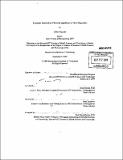| dc.contributor.advisor | Ernst Berndt and Mark Trusheim. | en_US |
| dc.contributor.author | Bignami, Adrian (Adrian A.) | en_US |
| dc.contributor.other | Harvard University--MIT Division of Health Sciences and Technology. | en_US |
| dc.date.accessioned | 2010-04-28T17:18:07Z | |
| dc.date.available | 2010-04-28T17:18:07Z | |
| dc.date.copyright | 2009 | en_US |
| dc.date.issued | 2009 | en_US |
| dc.identifier.uri | http://hdl.handle.net/1721.1/54672 | |
| dc.description | Thesis (S.M.)--Harvard-MIT Division of Health Sciences and Technology, 2009. | en_US |
| dc.description | Cataloged from PDF version of thesis. | en_US |
| dc.description | Includes bibliographical references (p. 53-56). | en_US |
| dc.description.abstract | In recent years, significant advances have been made in the realm of in vitro diagnostics with the development of novel tests which are able to meaningfully impact the course of a patients' disease management. This transformation has strained the traditional in vitro diagnostic business model and raised questions as to whether the economics support the commercial development of these tests. The goal of this study is to evaluate the economics of in vitro diagnostics from development to commercialization, with a focus on a specific a class of novel and complex tests called In Vitro Diagnostic Multivariate Index Assays (IVDMIA). My hypothesis is that the current dynamics of the market can only sustain a small number of such novel tests. To evaluate this hypothesis, I construct an economic model of the development of a hypothetical new in vitro diagnostics which focuses on both the cost of development and commercialization together with market potential and adoption. The analysis reviews specific break-even scenarios to determine the parameters which would allow for an economically viable complex in vitro diagnostic. The conclusion I reach based on this analysis is that only a very small number of medical conditions could economically support the development of a novel in vitro diagnostic. The medical conditions which could support the development of a novel test are governed by complexity, severity and prevalence of the disease. Given the dramatic impact these new tests may have on disease management, incentives may be required to offset the risks associated with expanding novel diagnostics into smaller but medically significant disease areas. | en_US |
| dc.description.statementofresponsibility | by Adrian A. Bignami. | en_US |
| dc.format.extent | 56 p. | en_US |
| dc.language.iso | eng | en_US |
| dc.publisher | Massachusetts Institute of Technology | en_US |
| dc.rights | M.I.T. theses are protected by
copyright. They may be viewed from this source for any purpose, but
reproduction or distribution in any format is prohibited without written
permission. See provided URL for inquiries about permission. | en_US |
| dc.rights.uri | http://dspace.mit.edu/handle/1721.1/7582 | en_US |
| dc.subject | Harvard University--MIT Division of Health Sciences and Technology. | en_US |
| dc.title | Economic potential for clinically significant in vitro diagnostics | en_US |
| dc.type | Thesis | en_US |
| dc.description.degree | S.M. | en_US |
| dc.contributor.department | Harvard University--MIT Division of Health Sciences and Technology | |
| dc.identifier.oclc | 607346985 | en_US |
